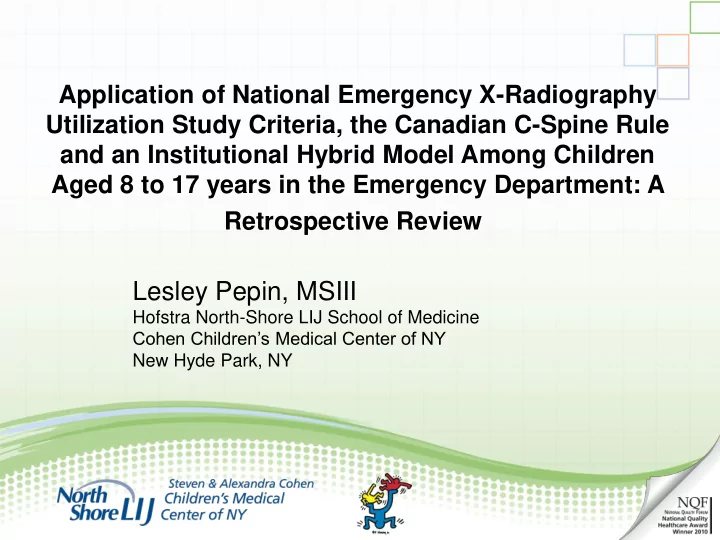

Application of National Emergency X-Radiography Utilization Study Criteria, the Canadian C-Spine Rule and an Institutional Hybrid Model Among Children Aged 8 to 17 years in the Emergency Department: A Retrospective Review Lesley Pepin, MSIII Hofstra North-Shore LIJ School of Medicine Cohen Children’s Medical Center of NY New Hyde Park, NY
Pediatric C-spine Clearance • Pediatric c-spine injuries - rare but devastating if missed • Validated clinical decision tools – NEXUS and CCR for adult use • No pediatric c-spine clearance tools validated Hoffman JR et al, N Engl J Med. 2000. Stiell IG et al, JAMA. 2001 .
Adult Clinical Decision Tools NEXUS CCR High Risk Criteria Focal deficits Dangerous MOI Midline tenderness Yes Imaging Parasthesias Altered mental status Indicated Yes Intoxication No Distracting Injuries Low Risk Criteria No Simple rear-end collision Imaging Found sitting in the ED Indicated No No Imaging Indicated Ambulatory at anytime No midline tenderness Delayed onset of neck pain Yes No Normal Neck ROM Yes No Imaging Indicated Hoffman JR et al, N Engl J Med. 2000. Stiell IG et al, JAMA. 2001 .
Pediatric C-spine Risk Factors • Pediatric Emergency Care Applied Research Network (PECARN) retrospectively identified 8 factors highly associated with CSI in children 0-16 years. – Altered mental status – Focal neurologic deficits – Complaints of neck pain – Torticollis – Substantial injury to the torso – Predisposing condition for c-spine injury – High risk MVC – Diving Leonard JC et al. Ann Emerg Med. 2011
CCMC Pediatric C-spine Protocol Development PECARN NEXUS CCR Cohen Children’s Medical Center C-spine Protocol
CCMC C-spine Protocol: NEXUS components 1. All high risk criteria absent • MOI: hanging, axial loading mechanism • MOI: high risk MVC, diving • Altered mental status (GCS <15, intoxication) • Focal neurologic deficit or paresthesias in upper extremity • Complaint of neck pain • Substantial torso injury • Condition predisposing for CSI • Distracting injury 2. Absence of midline tenderness 3. Normal neck range of motion
CCMC C-spine Protocol: CCR components 1. All high risk criteria absent • MOI: hanging, axial loading mechanism • MOI: high risk MVC, diving • Altered mental status (GCS < 15, intoxication) • Focal neurologic deficit or paresthesias in upper extremity • Complaint of neck pain • Substantial torso injury • Condition predisposing for CSI • Distracting injury 2. Absence of midline tenderness 3. Normal neck range of motion
CCMC C-spine Protocol: PECARN components 1. All high risk criteria absent • MOI: hanging, axial loading mechanism • MOI: high risk MVC, diving • Altered mental status (GCS < 15, intoxication) • Focal neurologic deficit or paresthesias in upper extremity • Complaint of neck pain • Substantial torso injury • Condition predisposing for CSI • Distracting injury 2. Absence of midline tenderness 3. Normal neck range of motion
CCMC C-spine Protocol MOI : Diving, hanging, football ‘spearing’ tackle, other axial loading mechanism, or high risk MVC Altered Mental Status or signs of intoxication Distracting injury Yes Focal neurologic deficit or paresthesias Complaints of neck pain Substantial torso injury Condition predisposing for CSI No Confrontational Exam Imaging Midline tenderness Indicated Yes Decreased Neck ROM No No Imaging Indicated
Hypothesis CCMC C-Spine protocol will identify all cervical spine injuries in children and reduce unnecessary cervical spine CT evaluation.
Initial Objective To determine the number of cervical spine CT scans that could have been avoided in injured children aged 3 to 17 with application of the NEXUS, CCR and CCMC c-spine protocols
Methods • Design: Retrospective chart review • IRB exempt • Inclusion criteria: Patients 3-17 years who received a cervical spine CT scan for blunt trauma in the ED from 1/2010 to 11/2013 • North Shore- LIJ Trauma • ACS level I adult trauma center • NY state level I pediatric trauma center
Demographics Total (n=486) % of total Age 3 to <8 yo 54 11% 8 to <18 yo 432 89% Gender Male 306 63% Female 180 37% Race White 211 43% Black 126 26% Hispanic 29 6% Asian 55 11% Other 65 13%
Mechanism of Injury Mechanism of Injury % of sample Motor Vehicle 18% Collision Pedestrian Struck 15% Sports Injury 13% Fall > 3ft or >5 stairs 12% Other* 42% *Includes: assault, axial load injury, bicycle accident, other motorized vehicle collision, or unknown mechansim
Clinically significant CSI in 1% Age MOI Diagnosis Treatment 4 Pedestrian C3 wedge Patient Struck deformity deceased due fracture to head trauma 10 Diving C7 Fracture Miami J collar 12 Diving C4,C5 Surgical compression intervention fracture 13 Bike Rotary Aspen collar accident subluxation at C1 and C2 16 Sports C5 and C6 Miami J collar injury avulsion fracture
All CSIs captured 3-7 yo CT SCAN NEXUS CCR CCMC C- USE spine Protocol Indicated 61% 70% 83% (33) (38) (45) Not 30% 9% 2% Indicated (16) (5) (1) Unable to 9% 20% 15% Determine (5) (11) (8)
All CSIs captured 8-17 yo CT SCAN NEXUS CCR CCMC C-spine USE Protocol Indicated 70% 58% 89% (303) (250) (384) Not 24% 16% 3% Indicated (102) (68) (14) Unable to 6% 26% 8% Determine (27) (114) (34)
Summary NEXUS and CCR would have reduced imaging utilization CCMC c-spine protocol would have identified all injuries, without lowering CT utilization Future Work: Prospective application of CCMC c-spine protocol
Thank You Cohen Children’s Medical Center Trauma Cohen Children’s Medical Center ED Department Francesca Bullaro, MD Jose M Prince, MD Jahn Avarello, MD Nathan A.M. Christopherson, MSN, MBA, RN, CPEN, CEN, EMT-P Long Island Jewish ED Sara Bressler, BA North Shore University Hospital Trauma Cameron Brenner, BA Department Alan Johnson, MD Matthew Bank, MD Yosef Dlugacz, PhD, Robert A Silverman, MD, MS
Recommend
More recommend